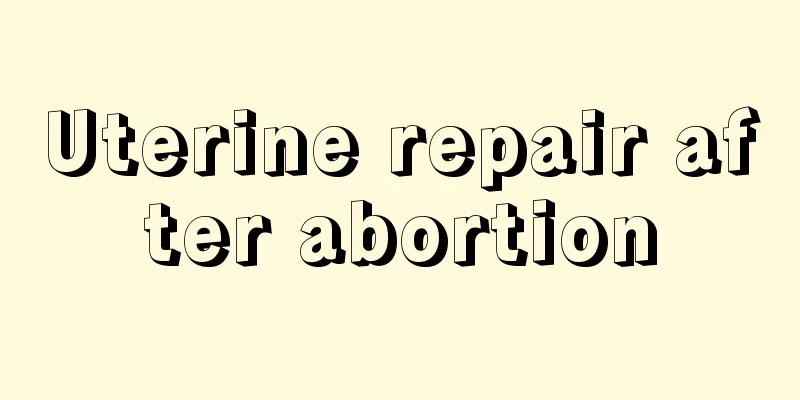Is it okay to sit in class after having an abortion?

|
Abortion is also known as artificial miscarriage. This operation is still relatively common in today's clinical medicine, because people's sexual concepts are gradually becoming more open, and the phenomenon of accidental pregnancies has also increased. After undergoing an abortion, women need to undergo certain physical conditioning to avoid leaving themselves with some sequelae. So, can I sit down and attend class after having an abortion? Let me introduce you to the relevant knowledge below! 1. Is it OK to sit in class after having an abortion? After having an abortion, you cannot sit in class for one week. Sitting for a long time can easily cause pelvic congestion and lower abdominal distension, and it will also affect the discharge of blood in the uterine cavity. In this case, it is recommended to rest for at least one week, rest in bed as much as possible, and do appropriate activities to help the blood accumulated in the uterine cavity flow out. Use medication for 5 to 7 days to help the uterus recover. At the same time, you should be careful to avoid sexual intercourse for one month after the abortion, because the cervix is dilated and sexual intercourse too early can easily cause endometrial inflammation. 2. The best time for abortion Early abortion is a common remedy for contraceptive failure. When the embryo is still relatively small, the uterus is not large, and the placenta has not yet formed, the pregnancy can be terminated using curettage or vacuum aspiration. So, when is the best time for abortion? The best time for abortion is generally before 9 weeks of pregnancy. However, to finally determine how long you can have an abortion, you also need to refer to some preoperative examination results. However, if the embryo is too large, or even has grown bones, it cannot be sucked out with the largest straw. In this case, you can only be hospitalized and induce labor with drugs or water bags, and then have the uterus cleaned after the embryo and most of the placenta are expelled. If induction of labor fails, curettage is needed, which is to use an instrument to directly scrape the embryo and placenta out of the uterus. This operation is risky and can easily cause cervical injury and increased bleeding during the operation. It also increases the risk of infection, uterine injury, and postoperative intrauterine adhesions. Therefore, if you plan to terminate an unexpected pregnancy, try to do it within 2 months of pregnancy. 3. What are the hazards of abortion? 1. Cervical damage caused during artificial abortion can easily lead to habitual abortion and premature birth during subsequent pregnancy. 2. The endometrium and myometrium are damaged during artificial abortion, leading to placental dysfunction after each pregnancy, seriously affecting fetal development and making stillbirth and premature birth more likely to occur. 3. Abortion can easily cause reproductive system infection, leading to fallopian tube inflammation and causing infertility or ectopic pregnancy. 4. If you become pregnant again after artificial abortion and curettage, postpartum hemorrhage is likely to occur due to placental blood circulation disorders. |
<<: What's wrong with the bloated belly?
>>: My waist hurts so much during menstruation that I can't stand up straight
Recommend
Treatment for itchy eyes during pregnancy
In fact, many pregnant women do not pay attention...
How many times can a woman have an abortion?
Every abortion causes great damage to a woman'...
6 most practical tips for whitening and sun protection
The first step: continuous whitening The ultravio...
What is the nutritional value of green beans? Can green beans be used to make soy milk?
When we mention green beans, we usually only think...
In hot weather, beware of this type of severe heatstroke - heat stroke
Author: Wang Meng, attending physician, Xuanwu Ho...
Come on, my period is coming. My chest hurts.
"Aunt Flo" is an affectionate name for ...
Umeng: In 2012, the number of active iOS users in China reached 85 million, and the number of active Android users reached 160 million
In 2012, the rapid development of mobile Internet...
What causes membranous dysmenorrhea
Many people wonder what causes membranous dysmeno...
My nipples are very itchy when I am five months pregnant
When you are five months pregnant, you will alway...
Nine reasons why women have itchy lower body, check it out
Many women in life will have the problem of itchi...
High risk of Down syndrome screening = "problem" in newborns? Experts: Too early to tell!
"The Down syndrome screening is high risk, t...
What are the dangers of drinking for girls?
Alcohol is very common, and you should pay attent...
New healthy trend: Adults add some milk every day
With the rapid development of my country's ec...
What are the differences between Trichomonas vaginitis and candidal vaginitis?
Vaginitis is a major disease that affects women&#...









